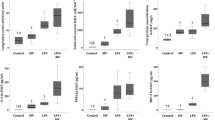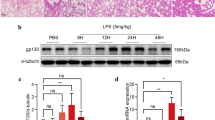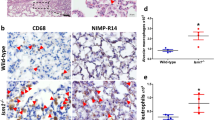Abstract
Objective
Long pentraxin PTX3 is an inflammatory mediator and a component of the humoral arm of innate immunity. PTX3 expression is increased in animals with acute lung injury (ALI) and in patients with sepsis or acute respiratory distress syndrome and is considered to be a potential biomarker for these diseases. However, the role of PTX3 in the pathogenesis of ALI is not fully understood. We hypothesized that PTX3, as an important immune modulator, may determine the severity of ALI.
Methods
Lipopolysaccharide (LPS) was intra-tracheally administrated to PTX3 knock-out (PTX3-KO) and wild-type (WT) mice. Lung injury, neutrophil infiltration, cell death, fibrin deposition, and tissue factor expression in the lung were determined. Local and systemic inflammatory responses were assessed by measuring cytokines in the lung and plasma.
Results
LPS instillation induced ALI in both PTX3-KO and WT mice. Interestingly, PTX3 deficiency significantly increased the magnitude/extent of lung injury compared to that in WT mice. The severe lung injury was accompanied by elevated neutrophil infiltration, cell death, and fibrin deposition in the lung. PTX3 deficiency also enhanced LPS-induced tissue factor expression/activation in the lung and increased tumor necrosis factor-alpha and monocyte chemoattractant protein-1 levels in the plasma.
Conclusion
Our data suggest that the endogenously expressed PTX3 plays a protective role in the pathogenesis of ALI and that a lack of PTX3 may enhance neutrophil recruitment, cell death, activation of coagulation cascades, and inflammatory responses in the lung.



Similar content being viewed by others
References
Garlanda C, Bottazzi B, Bastone A, Mantovani A (2005) Pentraxins at the crossroads between innate immunity, inflammation, matrix deposition, and female fertility. Annu Rev Immunol 23:337–366
Mantovani A, Garlanda C, Doni A, Bottazzi B (2008) Pentraxins in innate immunity: from C-reactive protein to the long pentraxin PTX3. J Clin Immunol 28:1–13
Baruah P, Dumitriu IE, Peri G, Russo V, Mantovani A, Manfredi AA, Rovere-Querini P (2006) The tissue pentraxin PTX3 limits C1q-mediated complement activation and phagocytosis of apoptotic cells by dendritic cells. J Leukoc Biol 80:87–95
Jaillon S, Jeannin P, Hamon Y, Fremaux I, Doni A, Bottazzi B, Blanchard S, Subra JF, Chevailler A, Mantovani A, Delneste Y (2009) Endogenous PTX3 translocates at the membrane of late apoptotic human neutrophils and is involved in their engulfment by macrophages. Cell Death Differ 16:465–474
Rovere P, Peri G, Fazzini F, Bottazzi B, Doni A, Bondanza A, Zimmermann VS, Garlanda C, Fascio U, Sabbadini MG, Rugarli C, Mantovani A, Manfredi AA (2000) The long pentraxin PTX3 binds to apoptotic cells and regulates their clearance by antigen-presenting dendritic cells. Blood 96:4300–4306
Agrawal A, Singh PP, Bottazzi B, Garlanda C, Mantovani A (2009) Pattern recognition by pentraxins. Adv Exp Med Biol 653:98–116
He X, Han B, Liu M (2007) Long pentraxin 3 in pulmonary infection and acute lung injury. Am J Physiol Lung Cell Mol Physiol 292:L1039–L1049
Han B, Mura M, Andrade CF, Okutani D, Lodyga M, dos Santos CC, Keshavjee S, Matthay M, Liu M (2005) TNFalpha-induced long pentraxin PTX3 expression in human lung epithelial cells via JNK. J Immunol 175:8303–8311
Souza DG, Soares AC, Pinho V, Torloni H, Reis LF, Teixeira MM, Dias AA (2002) Increased mortality and inflammation in tumor necrosis factor-stimulated gene-14 transgenic mice after ischemia and reperfusion injury. Am J Pathol 160:1755–1765
Okutani D, Han B, Mura M, Waddell TK, Keshavjee S, Liu M (2007) High-volume ventilation induces pentraxin 3 expression in multiple acute lung injury models in rats. Am J Physiol Lung Cell Mol Physiol 292:L144–L153
Dias AA, Goodman AR, Dos Santos JL, Gomes RN, Altmeyer A, Bozza PT, Horta MF, Vilcek J, Reis LF (2001) TSG-14 transgenic mice have improved survival to endotoxemia and to CLP-induced sepsis. J Leukoc Biol 69:928–936
He X, Han B, Bai X, Zhang Y, Cypel M, Mura M, Keshavjee S, Liu M (2010) PTX3 as a potential biomarker of acute lung injury: supporting evidence from animal experimentation. Intensive Care Med 36:356–364
Muller B, Peri G, Doni A, Torri V, Landmann R, Bottazzi B, Mantovani A (2001) Circulating levels of the long pentraxin PTX3 correlate with severity of infection in critically ill patients. Crit Care Med 29:1404–1407
Mauri T, Coppadoro A, Bellani G, Bombino M, Patroniti N, Peri G, Mantovani A, Pesenti A (2008) Pentraxin 3 in acute respiratory distress syndrome: an early marker of severity. Crit Care Med 36:2302–2308
Mauri T, Bellani G, Patroniti N, Coppadoro A, Peri G, Cuccovillo I, Cugno M, Iapichino G, Gattinoni L, Pesenti A, Mantovani A (2010) Persisting high levels of plasma pentraxin 3 over the first days after severe sepsis and septic shock onset are associated with mortality. Intensive Care Med 36:621–629
Varani S, Elvin JA, Yan C, DeMayo J, DeMayo FJ, Horton HF, Byrne MC, Matzuk MM (2002) Knockout of pentraxin 3, a downstream target of growth differentiation factor-9, causes female subfertility. Mol Endocrinol 16:1154–1167
Takano H, Inoue K, Yanagisawa R, Sato M, Shimada A, Morita T, Sawada M, Nakamura K, Sanbongi C, Yoshikawa T (2004) Protective role of metallothionein in acute lung injury induced by bacterial endotoxin. Thorax 59:1057–1062
Mura M, Han B, Andrade CF, Seth R, Hwang D, Waddell TK, Keshavjee S, Liu M (2006) The early responses of VEGF and its receptors during acute lung injury: implication of VEGF in alveolar epithelial cell survival. Crit Care 10:R130
Nishina K, Mikawa K, Takao Y, Maekawa N, Shiga M, Obara H (1997) ONO-5046, an elastase inhibitor, attenuates endotoxin-induced acute lung injury in rabbits. Anesth Analg 84:1097–1103
He X, Han B, Mura M, Li L, Cypel M, Soderman A, Picha K, Yang J, Liu M (2008) Anti-human tissue factor antibody ameliorated intestinal ischemia reperfusion-induced acute lung injury in human tissue factor knock-in mice. PLoS ONE 3:e1527
Singh I, Smith A, Vanzieleghem B, Collen D, Burnand K, Saint-Remy JM, Jacquemin M (2002) Antithrombotic effects of controlled inhibition of factor VIII with a partially inhibitory human monoclonal antibody in a murine vena cava thrombosis model. Blood 99:3235–3240
Mura M, Binnie M, Han B, Li C, Andrade CF, Shiozaki A, Zhang Y, Ferrara N, Hwang D, Waddell TK, Keshavjee S, Liu M (2010) Functions of type II pneumocyte-derived vascular endothelial growth factor in alveolar structure, acute inflammation, and vascular permeability. Am J Pathol 176:1725–1734
Mura M, Andrade CF, Han B, Seth R, Zhang Y, Bai XH, Waddell TK, Hwang D, Keshavjee S, Liu M (2007) Intestinal ischemia–reperfusion-induced acute lung injury and oncotic cell death in multiple organs. Shock 28:227–238
Tang PS, Mura M, Seth R, Liu M (2008) Acute lung injury and cell death: how many ways can cells die? Am J Physiol Lung Cell Mol Physiol 294:L632–L641
Salio M, Chimenti S, De Angelis N, Molla F, Maina V, Nebuloni M, Pasqualini F, Latini R, Garlanda C, Mantovani A (2008) Cardioprotective function of the long pentraxin PTX3 in acute myocardial infarction. Circulation 117:1055–1064
Deban L, Russo RC, Sironi M, Moalli F, Scanziani M, Zambelli V, Cuccovillo I, Bastone A, Gobbi M, Valentino S, Doni A, Garlanda C, Danese S, Salvatori G, Sassano M, Evangelista V, Rossi B, Zenaro E, Constantin G, Laudanna C, Bottazzi B, Mantovani A (2010) Regulation of leukocyte recruitment by the long pentraxin PTX3. Nat Immunol 11:328–334
Mukhopadhyay S, Hoidal JR, Mukherjee TK (2006) Role of TNFalpha in pulmonary pathophysiology. Respir Res 7:125
Hardy LA, Booth TA, Lau EK, Handel TM, Ali S, Kirby JA (2004) Examination of MCP-1 (CCL2) partitioning and presentation during transendothelial leukocyte migration. Lab Invest 84:81–90
Knight PR, Davidson BA, Nader ND, Helinski JD, Marschke CJ, Russo TA, Hutson AD, Notter RH, Holm BA (2004) Progressive, severe lung injury secondary to the interaction of insults in gastric aspiration. Exp Lung Res 30:535–557
Miller DL, Welty-Wolf K, Carraway MS, Ezban M, Ghio A, Suliman H, Piantadosi CA (2002) Extrinsic coagulation blockade attenuates lung injury and proinflammatory cytokine release after intratracheal lipopolysaccharide. Am J Respir Cell Mol Biol 26:650–658
Bastarache JA, Ware LB, Bernard GR (2006) The role of the coagulation cascade in the continuum of sepsis and acute lung injury and acute respiratory distress syndrome. Semin Respir Crit Care Med 27:365–376
Gando S, Nanzaki S, Morimoto Y, Kobayashi S, Kemmotsu O (1999) Systemic activation of tissue-factor dependent coagulation pathway in evolving acute respiratory distress syndrome in patients with trauma and sepsis. J Trauma 47:719–723
Napoleone E, Di Santo A, Bastone A, Peri G, Mantovani A, de Gaetano G, Donati MB, Lorenzet R (2002) Long pentraxin PTX3 upregulates tissue factor expression in human endothelial cells: a novel link between vascular inflammation and clotting activation. Arterioscler Thromb Vasc Biol 22:782–787
Napoleone E, di Santo A, Peri G, Mantovani A, de Gaetano G, Donati MB, Lorenzet R (2004) The long pentraxin PTX3 up-regulates tissue factor in activated monocytes: another link between inflammation and clotting activation. J Leukoc Biol 76:203–209
Sitrin RG, Brubaker PG, Fantone JC (1987) Tissue fibrin deposition during acute lung injury in rabbits and its relationship to local expression of procoagulant and fibrinolytic activities. Am Rev Respir Dis 135:930–936
Antonelli M, Azoulay E, Bonten M, Chastre J, Citerio G, Conti G, De Backer D, Lemaire F, Gerlach H, Groeneveld J, Hedenstierna G, Macrae D, Mancebo J, Maggiore SM, Mebazaa A, Metnitz P, Pugin J, Wernerman J, Zhang H (2009) Year in review in intensive care medicine, 2008: II. Experimental, acute respiratory failure and ARDS, mechanical ventilation and endotracheal intubation. Intensive Care Med 35:215–231
Garlanda C, Hirsch E, Bozza S, Salustri A, De Acetis M, Nota R, Maccagno A, Riva F, Bottazzi B, Peri G, Doni A, Vago L, Botto M, De Santis R, Carminati P, Siracusa G, Altruda F, Vecchi A, Romani L, Mantovani A (2002) Non-redundant role of the long pentraxin PTX3 in anti-fungal innate immune response. Nature 420:182–186
Bozza S, Bistoni F, Gaziano R, Pitzurra L, Zelante T, Bonifazi P, Perruccio K, Bellocchio S, Neri M, Iorio AM, Salvatori G, De Santis R, Calvitti M, Doni A, Garlanda C, Mantovani A, Romani L (2006) Pentraxin 3 protects from MCMV infection and reactivation through TLR sensing pathways leading to IRF3 activation. Blood 108:3387–3396
Acknowledgments
We thank Ms. Zhihong Yun for technical assistance, Dr. Martin M. Matzuk (Baylor College of Medicine, Houston) for the ptx3+/− mice, and Dr. J. H. Morrissey (University of Illinois at Urbana-Champaign) for the anti-TF antibody. This work is supported by the Canadian Institutes of Health Research (operating grants: MOP-13270 and MOP-42546).
Conflict of interest
The authors have no financial conflict of interest.
Author information
Authors and Affiliations
Corresponding author
Electronic supplementary material
Below is the link to the electronic supplementary material.
Rights and permissions
About this article
Cite this article
Han, B., Haitsma, J.J., Zhang, Y. et al. Long pentraxin PTX3 deficiency worsens LPS-induced acute lung injury. Intensive Care Med 37, 334–342 (2011). https://doi.org/10.1007/s00134-010-2067-2
Received:
Accepted:
Published:
Issue Date:
DOI: https://doi.org/10.1007/s00134-010-2067-2




